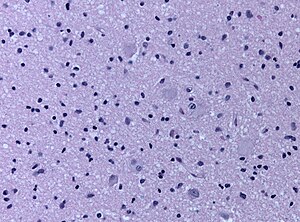Difference between revisions of "Cortical tuber"
Jump to navigation
Jump to search
Jensflorian (talk | contribs) (move) |
Jensflorian (talk | contribs) (GFAP image added) |
||
| Line 5: | Line 5: | ||
==General== | ==General== | ||
*Cortical tubers are malformative, epilepsy-associated.<ref>{{Cite journal | last1 = Cotter | first1 = JA. | title = An update on the central nervous system manifestations of tuberous sclerosis complex. | journal = Acta Neuropathol | volume = | issue = | pages = | month = Apr | year = 2019 | doi = 10.1007/s00401-019-02003-1 | PMID = 30976976 }}</ref> | *Cortical tubers are malformative, epilepsy-associated.<ref>{{Cite journal | last1 = Cotter | first1 = JA. | title = An update on the central nervous system manifestations of tuberous sclerosis complex. | journal = Acta Neuropathol | volume = | issue = | pages = | month = Apr | year = 2019 | doi = 10.1007/s00401-019-02003-1 | PMID = 30976976 }}</ref> | ||
*Seen in 80-90% of the TSC cases. | |||
*Gyrus is usu. thickened, raised, and occasionally dimpled. | |||
*Giant cells, dysmorphic neurons, disrupted cortical lamination, gliosis, calcifications. | |||
*Ballon cells are Vim+ve, MAP2+ve, Nestin+ve, GFAP+/-ve, NeuN+/-ve. | |||
*TSC2 has larger and more numerous tubers.<ref>{{Cite journal | last1 = Overwater | first1 = IE. | last2 = Swenker | first2 = R. | last3 = van der Ende | first3 = EL. | last4 = Hanemaayer | first4 = KB. | last5 = Hoogeveen-Westerveld | first5 = M. | last6 = van Eeghen | first6 = AM. | last7 = Lequin | first7 = MH. | last8 = van den Ouweland | first8 = AM. | last9 = Moll | first9 = HA. | title = Genotype and brain pathology phenotype in children with tuberous sclerosis complex. | journal = Eur J Hum Genet | volume = 24 | issue = 12 | pages = 1688-1695 | month = 12 | year = 2016 | doi = 10.1038/ejhg.2016.85 | PMID = 27406250 }}</ref> | |||
<gallery> | |||
File:Tuber_GFAP_20191014_012.jpg|GFAP sparing dysmorphic ballon cells. | |||
</gallery> | |||
==DDx== | ==DDx== | ||
* Focal cortical dysplasia ILAE type IIB (Tubers are usu. multifocal). | * [[Focal cortical dysplasia]] ILAE type IIB (Tubers are usu. multifocal). | ||
==See also== | ==See also== | ||
Revision as of 13:06, 14 October 2019
Cortical tubers are malformative lesions in the CNS observed in tuberous sclerosis complex (abbreviated TSC), an autosomal dominant syndrome.
General
- Cortical tubers are malformative, epilepsy-associated.[1]
- Seen in 80-90% of the TSC cases.
- Gyrus is usu. thickened, raised, and occasionally dimpled.
- Giant cells, dysmorphic neurons, disrupted cortical lamination, gliosis, calcifications.
- Ballon cells are Vim+ve, MAP2+ve, Nestin+ve, GFAP+/-ve, NeuN+/-ve.
- TSC2 has larger and more numerous tubers.[2]
DDx
- Focal cortical dysplasia ILAE type IIB (Tubers are usu. multifocal).
See also
References
- ↑ Cotter, JA. (Apr 2019). "An update on the central nervous system manifestations of tuberous sclerosis complex.". Acta Neuropathol. doi:10.1007/s00401-019-02003-1. PMID 30976976.
- ↑ Overwater, IE.; Swenker, R.; van der Ende, EL.; Hanemaayer, KB.; Hoogeveen-Westerveld, M.; van Eeghen, AM.; Lequin, MH.; van den Ouweland, AM. et al. (12 2016). "Genotype and brain pathology phenotype in children with tuberous sclerosis complex.". Eur J Hum Genet 24 (12): 1688-1695. doi:10.1038/ejhg.2016.85. PMID 27406250.

